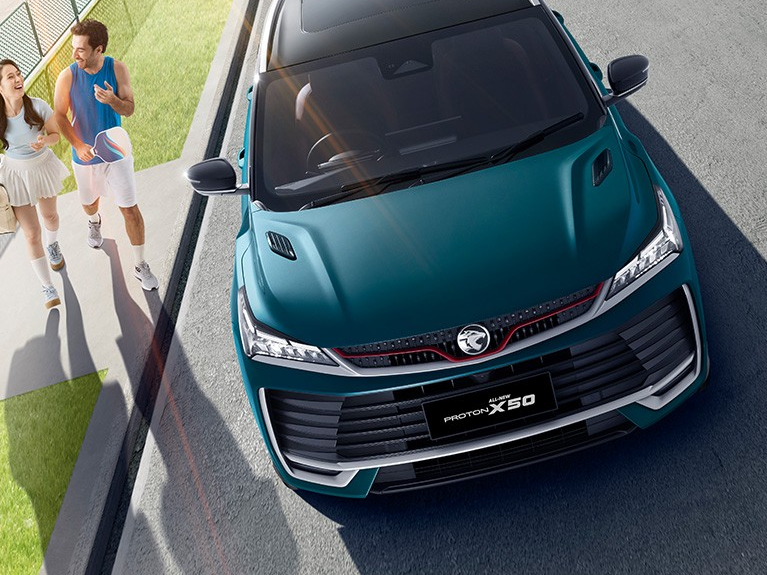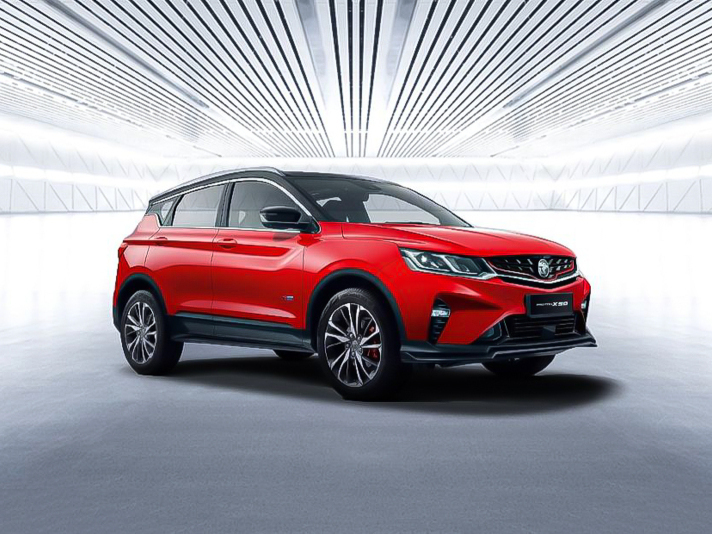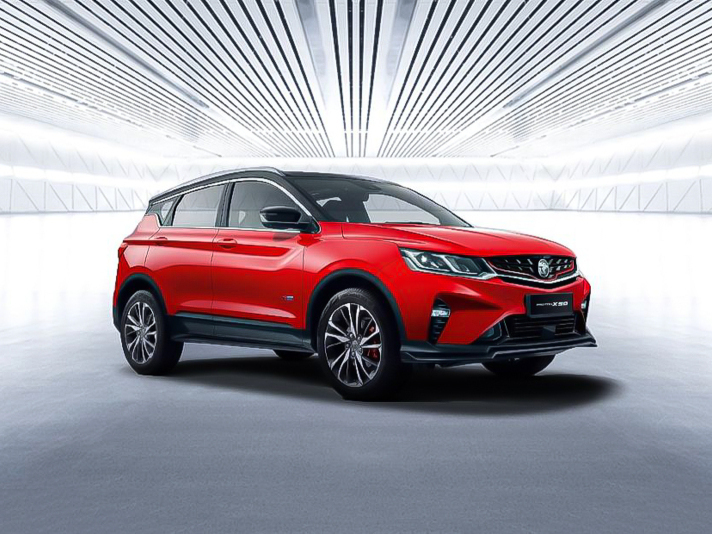Q
proton x50 made in which country
The Proton X50 is a collaborative effort between Malaysia's homegrown carmaker Proton and China's Geely Auto. It rolls off the production line right here in Malaysia, specifically at Proton's manufacturing hub in Tanjung Malim, Perak. Under the skin, it's based on Geely's Binyue platform, but Proton didn't just do a badge swap – they've tailored it for the local market. That means right-hand drive, a cooling system tweaked to handle our tropical heat, and interior trims that match what Malaysian buyers look for.
Since its launch in 2020, the X50 has been a key player in Proton's lineup and quickly shot up the popularity charts in Malaysia's B-segment SUV scene. Why? Well, it's hard to beat that combination of solid value for money, a good dose of smart tech – including that Advanced Driver Assistance System (ADAS) – and peppy performance from its 1.5-liter turbocharged engine. Being locally produced also helps it score a tax exemption from the government, giving it an extra edge in the competitive market.
But the Proton-Geely partnership is about more than just one hit model. It's been a catalyst for upgrading Malaysia's automotive supply chain. The tech transfer from Geely has really upped the game for local manufacturing – take the Tanjung Malim plant, for example, which now uses Geely's standardized production system to ensure the X50 meets international quality benchmarks. On top of that, it's created plenty of jobs and provided a platform for nurturing local technical talent.
Special Disclaimer: This content is published by users and does not represent the views or position of PCauto.
Related Q&A
Q
How much horsepower does the X50 Turbo have?
The Proton X50 Turbo is powered by a 1.5-liter three-cylinder turbocharged engine that cranks out 177 horsepower and a peak torque of 255 Nm. This engine features direct fuel injection and is mated to a 7-speed dual-clutch transmission, delivering pretty impressive performance—especially suited for Malaysian city driving and highway overtaking needs. What's worth noting is that the X50 Turbo's engine is tuned to emphasize low-end torque, so you get that nice, punchy power response in everyday driving, and it's relatively fuel-efficient too. For Malaysian buyers, the X50 Turbo's powertrain setup is pretty competitive in its SUV class, and with local assembly, the price becomes even more appealing. If you're craving more performance, keep an eye on the X50 Flagship variant, which bumps the horsepower up to 181 and comes with a fancier suite of driver assistance systems. Malaysia's hilly terrain and hot climate really put a car's powertrain to the test, but the X50 Turbo's cooling system and transmission tuning have been optimized for these conditions, ensuring reliable long-term use.
Q
How much is Proton X50 in Singapore?
The Proton X50 retails for around SGD 100,000 to SGD 120,000 in Singapore, with the exact price depending on the trim level and dealer promotions. Thanks to Singapore's high car import taxes and Certificate of Entitlement (COE) costs, it's significantly pricier than in Malaysia. For Malaysian buyers, the X50 goes for about MYR 80,000 to MYR 110,000 locally, offering much better value for money.
Under the hood, it's packing a 1.5-liter turbocharged engine that delivers solid power and fuel efficiency—perfect for city driving. If you're planning to buy one in Singapore, make sure to look into the local COE policies and loan options first, since these can really impact the total cost.
Plus, the Proton X50 has a solid reputation in Southeast Asia, especially when it comes to safety features and tech. Definitely worth checking out.
Q
What is the engine of Proton X50?
The Proton X50 is powered by a 1.5-liter turbocharged direct-injection (TGDI) three-cylinder engine, co-developed by Proton and Geely. This engine comes in two tuning versions: the standard variant delivers 150 horsepower and 225 Nm of torque, while the Flagship trim ups the ante to 177 horsepower and 255 Nm. It's mated to a 7-speed dual-clutch transmission (DCT), striking a balance between performance and fuel efficiency.
Under the hood, the engine borrows technology from Geely's BMA modular platform, featuring lightweight construction and direct fuel injection. These advancements help keep fuel consumption in check and ensure compliance with Malaysia's stringent EURO 4 emission standards. A notable point is that Proton has tweaked the engine specifically for local conditions – think a cooling system and ECU calibration optimized to handle our hot and humid weather. Plus, owners can run it on RON 95 petrol, which helps keep day-to-day running costs down.
For Malaysian buyers, small-displacement turbo engines like this have been gaining traction as the market favorite in recent years. Compared to traditional naturally aspirated engines, they deliver more torque at lower revs, making them well-suited for city driving. While three-cylinder setups do involve a slight trade-off in terms of smoothness, the use of a balance shaft has significantly reduced vibration issues. What's more, maintenance costs are on par with those of four-cylinder engines.
Q
Will the X50 facelift have a new engine?
As for whether the facelifted X50 will get a new engine, there's no official word yet. But looking at Proton's usual update strategy, facelifts typically focus more on tweaks to the exterior, interior, and features. The engine is likely to stay the same: the existing 1.5T three-cylinder turbo setup. It's proven itself reliable in the Malaysian market, and with its fuel efficiency plus 147hp/226Nm output, it fits the B-segment SUV bill. If you're craving more power, keep an eye out—Proton might roll out a high-performance variant or a hybrid model down the line. After all, the global trend is going electric, and local brands are also ramping up their new energy tech game. Best bet is to check Proton's official website or local Malaysian auto media for the latest scoop. And a quick tip for car buyers: beyond just power figures, factor in real-world stuff like maintenance costs and after-sales network. At the end of the day, the long-term ownership experience is what really matters.
Q
Which country made Proton X50?
The Proton X50 is a compact SUV co-developed and produced by Malaysian national automaker Proton and China's Geely. Its manufacturing base is located in Tanjung Malim, Perak, Malaysia. Based on Geely's Binyue platform, the model has undergone several localized adaptations for the Malaysian market, including right-hand drive configuration, safety features compliant with local regulations, and an air conditioning system tailored for tropical climates. The Proton X50 is powered by a 1.5-liter turbocharged engine and offers multiple driving modes, balancing performance with fuel efficiency. As a key strategic model for the Proton brand, the X50 has gained popularity among Malaysian consumers thanks to its high value for money and rich technological configuration, such as the advanced driver assistance system (ADAS) and smart connectivity features, further solidifying Proton's competitiveness in the local market. Notably, the collaboration between Proton and Geely has not only enhanced the technical content of the X50 but also driven the upgrading of Malaysia's automotive industry chain, with increasing local production ratios creating more job opportunities and facilitating technology transfer locally.
Q
Is the Proton X50 engine a VOLVO?
The Proton X50's engine isn't directly sourced from Volvo. Instead, it's built based on the modular architecture technology co-developed by Geely and Volvo. Its 1.5-liter three-cylinder turbocharged engine is part of the "Drive-E" powertrain family jointly developed by Geely and Volvo, but Geely took the lead in tuning it to suit Malaysian market needs. This engine incorporates some of Volvo's technical patents, such as direct fuel injection and lightweight design, though the production line and supply chain are independently managed by Geely's system. It's worth adding that the X50's powertrain has undergone local adaptation, including cooling system optimizations for tropical climates and adjustments for RON95 gasoline compatibility, which differ from the calibration of Volvo's original engines. Malaysian owners will notice Geely badges in the X50's engine bay rather than Volvo logos, but the technical origins do reflect the synergy following Geely's acquisition of Volvo. This kind of technology-sharing model is common in the automotive industry – for example, multiple brands under the Volkswagen Group also share engine platforms, which helps reduce R&D costs while ensuring core performance.
Q
Is the X50 a good car to buy?
The Proton X50 is an SUV that Malaysian consumers should definitely consider. It offers solid value for money and competitiveness in the local market. Under the hood, it's powered by a 1.5-liter turbocharged engine, available in two power tunes: the standard variant puts out 150PS, while the performance version cranks it up to 177PS. Both are mated to a 7-speed dual-clutch transmission, delivering smooth power delivery and decent fuel efficiency—perfect for city commutes and long drives alike.
The X50 doesn't skimp on features either. It comes loaded with goodies like Advanced Driver Assistance Systems (ADAS), a panoramic sunroof, a digital instrument cluster, and smart connectivity functions, which really shows Proton's commitment compared to its rivals. Plus, as a homegrown brand, Proton has an edge with its after-sales service network and parts availability, keeping maintenance costs relatively low—something Malaysian buyers definitely care about.
Of course, before making a purchase, it's always a good idea to take it for a test drive to see if the suspension setup and noise insulation meet your personal taste. You might also want to check out competitors like the Honda HR-V or Toyota Corolla Cross, then pick the one that best fits your budget and needs. All in all, the X50 strikes a nice balance between performance, features, and price, making it especially appealing to young families looking for a tech-savvy and practical ride.
Q
What are the common Proton X50 problems?
The Proton X50, a popular B-segment SUV in the Malaysian market, delivers a well-rounded performance overall, though some owners have reported a few common issues. For instance, certain models may exhibit slight jerking from the dual-clutch transmission (DCT) during low-speed driving – a characteristic typical of this transmission type. It’s advisable to stick to regular maintenance and avoid prolonged low-speed creeping to optimize the experience. Additionally, a small number of users have mentioned occasional lag or freezing with the infotainment system, which can be resolved through software updates at official service centers. When it comes to noise insulation, there’s still room for improvement at highway speeds, with tire noise being particularly noticeable; upgrading to quieter tires later might help mitigate this. Notably, the 1.5T three-cylinder engine in the Proton X50 performs better than expected in terms of vibration control, though it’s recommended to keep an eye on engine mount aging after long-term use. The standard Advanced Driver Assistance System (ADAS) has also seen continuous optimization through OTA updates for better local adaptation, so owners should ensure their systems are up to date. Overall, most of these issues are common across the segment, and Proton’s extensive after-sales network – with 140 service centers nationwide – means owners can get support when needed. Regular maintenance and timely software updates go a long way in enhancing the driving experience.
Q
How much is the Proton X50 2024?
The 2024 Proton X50's prices in Malaysia vary by trim level. The entry-level Standard variant starts at around RM86,300, while the top-spec Flagship model goes for approximately RM113,300. Exact pricing may fluctuate slightly depending on optional configurations or promotional offers. As a best-selling SUV from Malaysia's homegrown brand, the Proton X50 is powered by a 1.5-liter turbocharged engine available in two tunes, delivering 150PS and 177PS respectively. It comes packed with advanced driver assistance systems like adaptive cruise control and lane keeping assist, making it a hit among young families and urban commuters for its strong value proposition. It's worth noting that the X50 shares its technical platform with the Geely Binyue but has been localized for Malaysian roads and consumer preferences – the suspension setup, for instance, prioritizes comfort while still maintaining decent fuel efficiency. The warranty package, offering 5 years with unlimited mileage, is another plus for buyers mindful of long-term ownership costs. If you're in the market for a compact SUV, head to an authorized dealer for a test drive. It's also a good idea to compare it with segment rivals like the Perodua Ativa or Honda HR-V to pick the one that best fits your budget and needs.
Q
What is the fuel consumption of the X50 2025?
Let's talk about the 2025 Proton X50's fuel efficiency. Official figures tell us the 1.5T Standard variant sips around 6.4 liters per 100km in mixed driving, while the 1.5T Flagship nudges up slightly to about 6.7L/100km. Of course, real-world numbers can vary a bit depending on how you drive, the roads you take, and how much you're carrying.
Under the hood, that 1.5-liter turbo engine paired with the 7-speed dual-clutch gearbox does a solid job on fuel economy – it's well-suited for both Malaysian city commutes and highway stretches. If you're keen to squeeze even more km out of each liter, stick to smooth driving habits: avoid jackrabbit starts and sudden stops. Regular maintenance helps too – keeping an eye on tire pressure and swapping out the air filter when needed are simple tweaks that can really boost efficiency.
What's impressive is how this B-segment SUV strikes a nice balance between fuel sipping and performance. It's no wonder the X50 remains a top pick for Malaysian buyers who want something that's easy on the wallet and practical for daily use.
Popular Cars
Model Year
Car Compare
Car Photo
Latest Q&A
Q
How much is 1 horsepower?
Horsepower (hp) is a unit of power that measures how much work a horse can do in one second—specifically, lifting 550 pounds one foot off the ground. In metric terms, that’s roughly 745.7 watts. The term was coined by engineer James Watt to compare steam engines to the workhorses they were replacing.
In cars, horsepower tells you how strong an engine is, but it’s not the whole story. Torque, weight, and drivetrain efficiency all shape how a car actually feels on the road. Also worth noting: there are slight variations in how horsepower is measured. For example, metric horsepower (PS) is about 0.986 hp, though the difference is negligible in everyday talk.
When shopping for a car, don’t just fixate on horsepower. Think about how you’ll use it. A small turbocharged engine might deliver better low-end torque for stop-and-go traffic, while a high-horsepower engine could be overkill for city driving. And if you’re looking at EVs, remember their power is often listed in kilowatts (kW)—where 1 kW equals about 1.34 hp. Knowing these conversions helps compare different powertrains more accurately.
Q
How to calculate main engine power?
The calculation of main engine power is usually based on the physical relationship between torque and RPM, with the formula being * * power (kW)=torque (Nm) x RPM ÷ 9549 * *, or * * horsepower (HP) in English units=torque (lb ft) x RPM ÷ 5252 * *. In actual measurement, manufacturers will collect data and draw power speed curves under specific operating conditions through engine bench testing, while commonly used calibration values by consumers (such as maximum power) are mostly theoretical peak values. It should be noted that the power on the wheels (the actual power transmitted to the wheels) may be lower than the engine output value due to factors such as transmission efficiency and transmission losses. This is also why modification enthusiasts often verify actual performance through chassis dynamometers. In addition, technologies such as turbocharging and variable valve timing can optimize combustion efficiency and indirectly improve power performance, while electric vehicles directly output instantaneous maximum torque through motor characteristics, and the power calculation logic is different from traditional internal combustion engines. If you have doubts about the specific vehicle model data, you can refer to the official technical manual or professional evaluation report.
Q
What does a 1.6 litre engine mean?
A 1.6-liter engine means the total displacement of all cylinders is 1.6 liters—in other words, the combined volume swept by the pistons from top to bottom dead center is 1,600 cubic centimeters. Generally, a larger displacement means more power, but it also leads to higher fuel consumption. Engines of this size are very common in the local market because they strike a good balance between performance and fuel efficiency, making them ideal for daily commuting and family use.
Displacement is one of the key indicators of engine performance, but real-world performance also depends on other technologies, like turbocharging, fuel injection systems, and variable valve timing. These can make engines of the same displacement produce different power outputs and efficiency levels. For example, some 1.6L turbocharged engines can deliver power close to a naturally aspirated 2.0L engine while being more fuel-efficient.
When choosing an engine, it’s not just about displacement—you should also consider your driving habits and needs. If you frequently drive long distances or at high speeds, a bigger engine might be preferable, while a smaller turbocharged unit could be the smarter choice for city driving.
Q
Is a 1.6 L engine good?
The 1.6L engine strikes a good balance for everyday driving. It delivers enough power for city commutes and occasional highway trips while maintaining decent fuel efficiency. Maintenance costs are reasonable too—a practical choice for family cars.
Naturally aspirated 1.6L engines are particularly reliable, with mature tech that prioritizes durability and low upkeep. If you want extra punch, turbocharged 1.6L variants can match the performance of some 2.0L naturally aspirated engines without sacrificing much fuel economy.
That said, your driving habits matter. Frequent long-distance drivers might find 1.6L a bit underwhelming, but it’s more than adequate for urban errands. Keep in mind, performance varies across brands—always test-drive before deciding.
Q
Is a 1.5 litre engine good?
Whether a 1.5L engine is right for you depends on your driving needs. For city commuting and daily errands, this displacement performs exceptionally well—it’s fuel-efficient, cheaper to maintain, and ideal for stop-and-go traffic. Plus, many modern 1.5L turbocharged engines now deliver power close to traditional 2.0L naturally aspirated ones, easily handling most family trips. If you’re mainly driving in urban areas with occasional highway runs, a 1.5L is plenty. But if you frequently haul heavy loads uphill or crave sharper throttle response, you might want to consider a larger engine. Keep in mind, though: advancements like optimized intake/exhaust systems and direct injection have given smaller turbo engines decent low-end torque, which is a big help in crawling traffic. So beyond displacement, pay attention to how the engine is tuned and what tech’s under the hood.
View MoreRelated News

The all-new Proton X50 has sold over 6,000 units in a month and a half since its launch, becoming the champion in its segment.
RobertSep 18, 2025

2025 Proton X50 launched for 5 days and has received 8,000 orders, with 999 units delivered
RobertAug 1, 2025

2025 Proton X50 Facelift Debuts with New 1.5L Four-Cylinder, Priced from RM89,800
AshleyJul 28, 2025

Proton X50 Interior Revealed: A Practical Space Designed for Young Drivers
LienJul 3, 2025

2025 Proton X50 Facelift: Major Upgrades & Possible 4-Cylinder Engine!
RobertJun 13, 2025
View More

















Pros
Cons